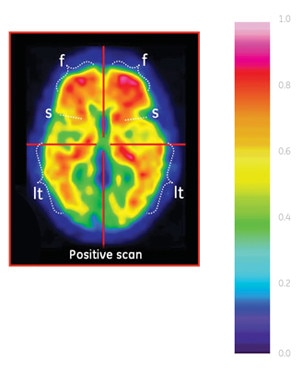See Important Safety Information About Vizamyl at the bottom of this page.
Prior to Vizamyl administration, please read the Full Prescribing Information.
For more information about Vizamyl, including efficacy and safety, please visit the Vizamyl Brand Website.
Vizamyl Brand Website.
Color images provide a visualization of flutemetamol uptake that can be shared with referring physicians, patients, and caregivers to help enhance communication.
- Vizamyl positron-emission tomography (PET) images are displayed using a color scale with a continuous progression of low through high intensity (eg, rainbow or Sokoloff)1

f, frontal; s, striatal; lt, lateral temporal.
Representative positive scan; scans will vary. Vizamyl images should be interpreted only by readers who have completed the Vizamyl Electronic Reader Training Program provided by GE Healthcare and available at Readvizamyl.com. For more information, contact Medical Affairs at 800 654 0118 (option 2, then option 3).
Image Misinterpretation: Errors may occur while interpreting Vizamyl PET images. Image interpretation is performed independently of the patient's clinical information. The use of clinical information in the interpretation of Vizamyl images
has not been evaluated and may lead to errors. Extensive brain atrophy may limit the ability to distinguish grey and white matter on a Vizamyl scan. Motion artifacts may distort the image. Images should be interpreted only by readers who have completed
a reader training program available from GE Healthcare.
Vizamyl PET images in color help reveal amyloid deposition.1
Negative Scan
A negative Vizamyl scan indicates sparse to no amyloid neuritic plaques.
- Shows more radioactivity in the white matter than in the grey matter, creating clear grey-white matter contrast
Positive Scan
A positive Vizamyl scan indicates moderate to frequent amyloid neuritic plaques.
- Shows at least one cortical region with reduction or loss of the normally distinct grey-white matter contrast
- Has one or more regions with increased cortical grey matter signal and/or reduced or absent grey-white matter contrast
- May have one or more regions in which grey matter radioactivity is as intense as, or exceeds, the intensity in adjacent white matter
Images at right:
Representative negative and positive scans; scans will vary. Images displayed using the rainbow color scale. Vizamyl images should be interpreted only by readers who have completed the Vizamyl Electronic Reader Training Program provided by GE Healthcare and available at Readvizamyl.com. For more information, contact Medical Affairs at 800 654 0118 (option 2, then option 3).
Click here to see the Full Prescribing Information for additional details on imaging and interpretation, including selection of appropriate color scales.
1. Vizamyl [prescribing information]. Arlington Heights, IL: GE Healthcare; 2013.